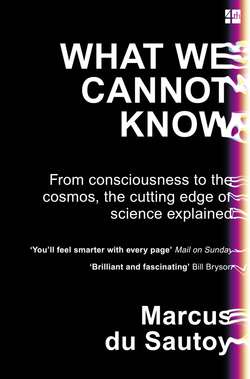Читать книгу What We Cannot Know: Explorations at the Edge of Knowledge - Marcus Sautoy du - Страница 44
NUMBERS AT THE EDGE
ОглавлениеFrom the atomistic point of view, if I draw two lines on the page then each line will be made from a certain number of these indivisible atoms and hence their lengths would be in a ratio of whole numbers corresponding to the number of atoms making up each line. But things didn’t turn out to be so orderly. In fact, it was Pythagoras’ own theorem about right-angled triangles that revealed that the world of geometry could give rise to lines whose relative lengths could not be captured by simple fractions.
The dimensions of my dice already have hidden in them a challenge to this atomistic view of nature. Take two of the edges of the cube at 90 degrees to each other. They have equal length. Now consider the diagonal line across the face of the cube that completes the triangle made up from the two edges of equal length. How long is this diagonal line relative to the shorter sides?
Pythagoras’ theorem about right-angled triangles says that the square of the length of the diagonal is equal to the sum of the squares of the lengths of the two shorter sides. If I set the length of the sides of my dice as 1, then Pythagoras’ theorem implies that the length of the diagonal across the face of my dice is a number which, when you square it, is equal to 2. So what is this number?
The Babylonians had been fascinated by the challenge of calculating this length. Dating back to the Old Babylonian period (1800–1600 BC), a tablet housed at Yale University has an estimate for the distance. Written using the sexagesimal system, or base 60, they got the length to be:
which in decimal notation comes out at 1.41421296296 …, where the 296 repeats itself infinitely often. It is true of all fractions that when written as decimals they repeat themselves after some point. Indeed, any decimal expansion which does repeat itself can always be written as a fraction. The Babylonian calculation is quite a feat. It is correct to six decimal places. But when you square that fraction it just misses being 2. What the ancient Greeks discovered is that however hard the Babylonian scribes tried, they would always find that their fractions just missed squaring to 2.
It was one of Pythagoras’ followers, Hippasus, who is credited with the discovery that the Babylonians were doomed to failure. He proved that the length of this diagonal across the side of my dice could never be expressed as a fraction.
Pythagoras’ theorem about right-angled triangles implied that this long side had length the square root of 2 times the length of the short sides. But Hippasus could prove that there was no fraction whose square was exactly 2. The proof uses one of the classic tools in the mathematician’s arsenal: proof by contradiction. Hippasus began by assuming there was a fraction whose square was 2. By some deft manipulation this always led to the contradictory statement that there was a number that was both odd and even. The only way to resolve this contradiction was to realize that the original assumption must have been false: there can be no fraction whose square is 2.
His fellow Pythagoreans were reputed to be dismayed by the revelation that their beautiful right-angled triangles could produce such inharmonic lengths. The sect took a vow of silence, but when Hippasus let the discovery out of the bag, the story goes that he was drowned at sea for revealing such disharmony in the physical world. But these new numbers, called irrational numbers because they are not ratios of whole numbers, were not so easily silenced.
Irrational lengths inside the cube.
I certainly have the feeling that this length exists. I can see it on a ruler held up against the long side of the triangle. It is the distance between two opposite corners of any side of my dice. Yet try to write down the number as an infinite decimal and I can never capture it. It begins 1.414213562 … and then continues to infinity never repeating itself.
